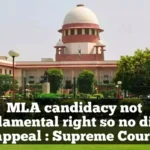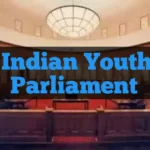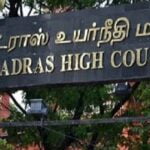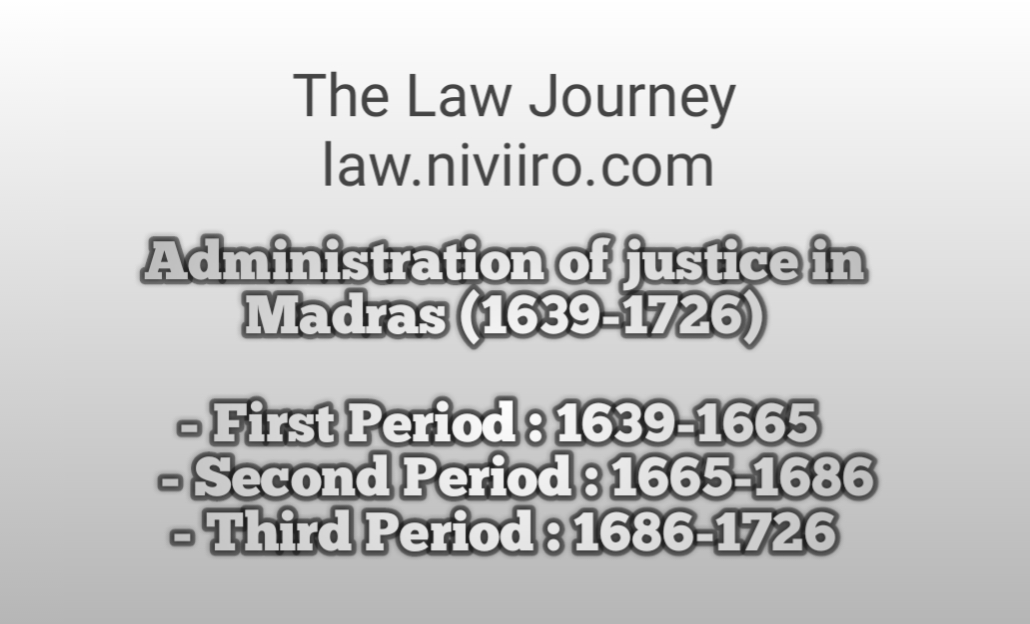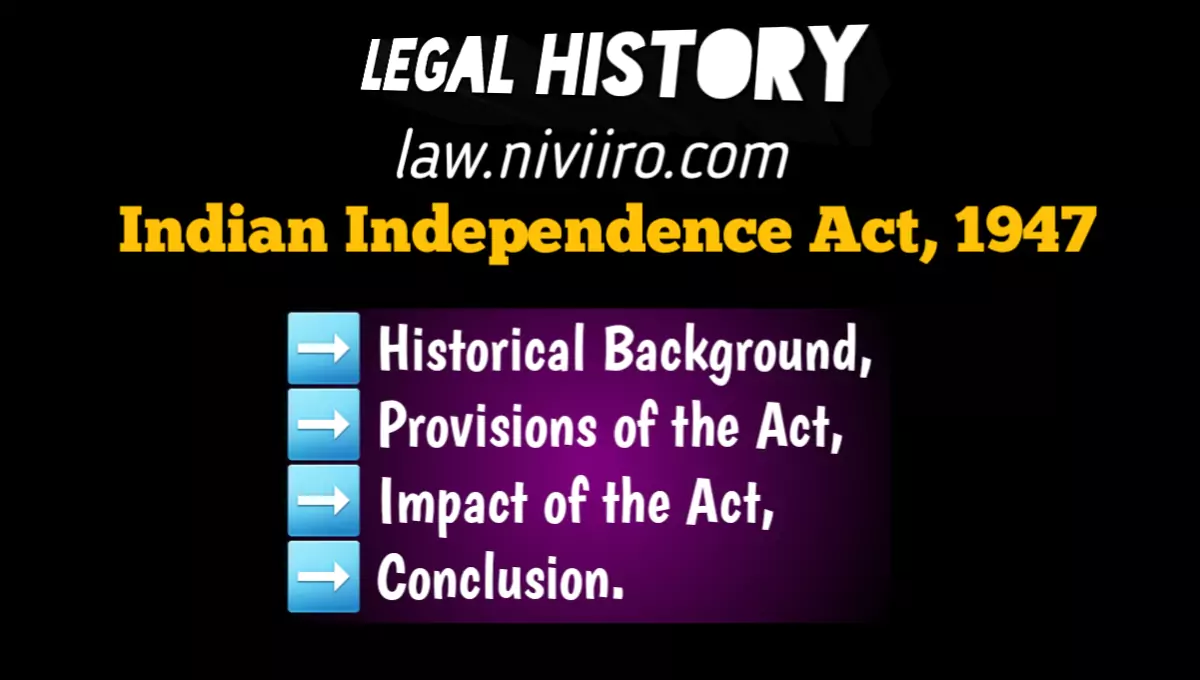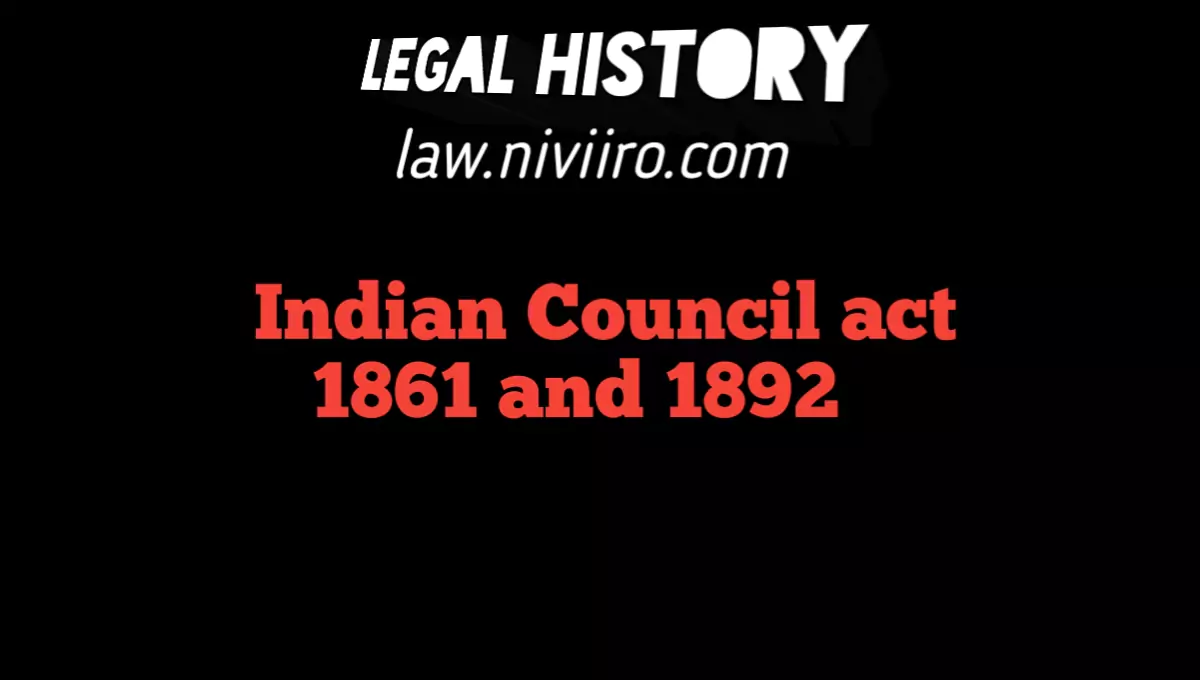Administration of justice in Madras (1639-1726),The early centres of British power in India were the three presidency towns of Madras Bombay and Calcutta which were founded by the British.
Madras was the first presidency town to be established by the British in India.
There were three administration stages in Madras.
(1)First stage from 1639 to 1665
(2)Second period which runs from 1665 to 1686
(3)The third form 1686 to 1726
First Period : 1639-1665 | Administration of justice in Madras (1639-1726)
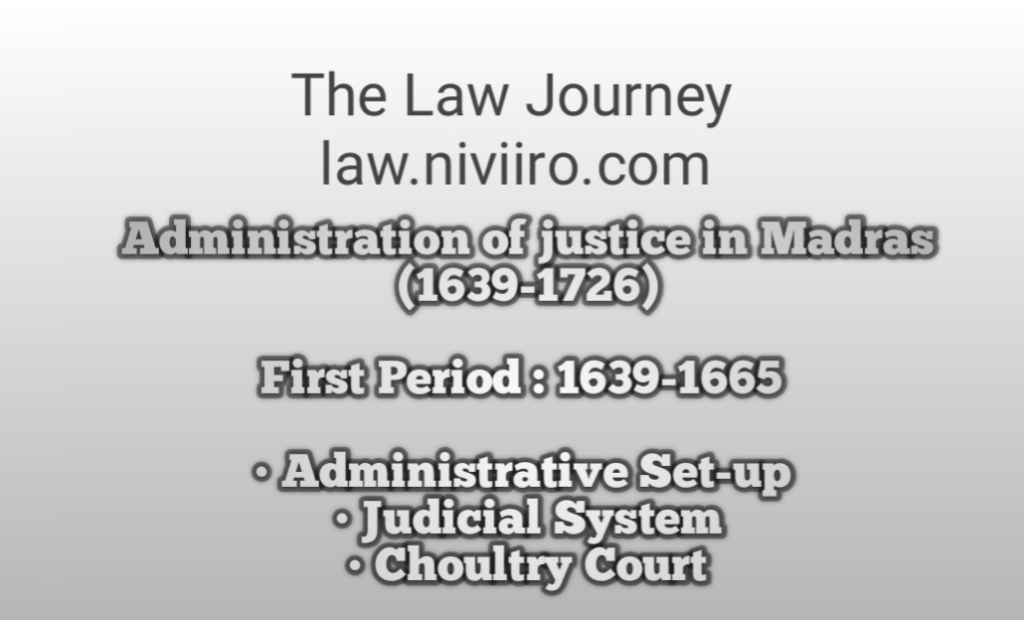
Madras was founded in 1639 by Francis Dey, who acquired a piece of land from the Hindu king Chandragiri to build a fortified factory. The factory was named Fort St. George. Europeans and British lived inside the factory and it was known as the White Town. King Chandragiri also gave the Company full power and rights over the land.
Later on, many Indians were attracted to this place due to trade and lived outside the factory. The small village came to be known as Black Town, the whole area of White and Black Town came to be known as Madras.
Administrative Set-up (Administration of justice in Madras )
Madras was given the status of an agency.The administrative head was called an agent and the council helped him for administration. The nature of the affairs of the company was commercial.
Judicial System
Agents and councils dealt with cases in White Town, and cases of serious offenses were referred to the Company in England.
Choultry Court
A choultry court was established with Adigar as a judge to decide petty civil and criminal cases of the natives. The Choultry Court was only a court of petty cases.there was no established procedure or forum for the trial of serious cases arising in the black city.
Second Period : 1665-1686 | Administration of justice in Madras (1639-1726)
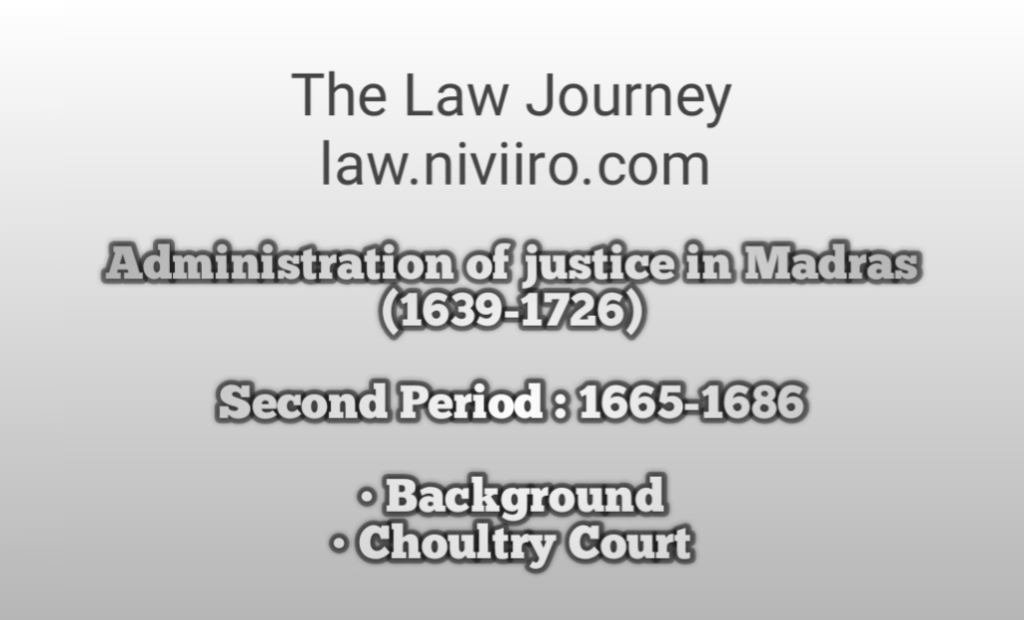
Mrs. Ascencia Dawes was brought to trial before the Agent and the Council on charges of murdering her handmaiden. As was their usual practice, the Agent and the Council, being unsure of their powers in such matters, referred the matter to the Company’s officers in England for advice.
The Company decided to give effect to the charter of 1661 in Madras and for this purpose granted the agent the status of governor.
This step was necessary because the Charter vested judicial power in the Governor and not in the Agent and Council, one of the effects of implementing the Charter of 1661 was that the judicial power of the Governor and the Council extended not only to the British but For all the people living in the settlement.Thus the agency of Madras became the Presidency in 1665.Soon after, the governor and council, with the help of a jury, prosecuted Mrs. Dawes.
Both grand and petty juries were used. The small jury consisted of six Englishmen and six Portuguese.This was the first jury trial held in Madras.
Streyansham Master became the Governor of Madras from 1667 to 1681.The governor recognized the entire judicial system of Madras required to introduced reforms in the functioning of the courts above it.
The court used to meet twice a week and decide all civil and criminal cases with the help of 12 jurors.Now the court was designed as a High Court and was formally inaugurated on March 27, 1678.
Choultry Court (Administration of justice in Madras )
The old Choultry Court was reconstituted and Adigar was replaced by three English servants of the Company, known as the Pay Master, Mint Master and Custom Master.
They could decide cases up to 50 pagodas
Third Period : 1686-1726 | Administration of justice in Madras (1639-1726)

During the phase two important courts were established in 1686.
(1) Admiralty Court
(2) Mayor’s Court
Admiralty Court (Administration of justice in Madras )
The Admiralty Court in Madras was established on 12 April 1686 and the court proceedings started on 10 July 1686.
Emergence of Admiralty Court (Administration of justice in Madras )
The main objective of the establishment of the Admiralty Court was to stop the increasing criminal cases.
The company was given a monopoly of trade in Asia, Africa and the Americas. And if any British wanted to do business, then they had to take license from the East India Company, but the rights of the company were being violated.
Other British merchants called the Interlopers and because of this The Court having jurisdiction to punish such traders was felt. To tackle the rise in the crime of piracy on the high seas they needed the court of the Admiralty.
So the court consisted of a person ‘learned in civil law’ who was a judge appointed by the company and two other Merchants appointed as advisors. This court was established where it was most needed.
John Biggs was the first judge advocate of this court.
Functions of the Admiralty court (Administration of justice in Madras )
The court could decide all matters of the commercial and maritime nature.
The court could also decide all civil and criminal cases.
The court enforced the rules of equality, good conscience and better law.
Thus the Admiralty Court became the ‘General Court of Madras’.
But unfortunately Sir John Biggs died in 1689 and Sir John Dolbane was appointed as Judge Advocate in 1692 but after some time he was dismissed from his office on charges of taking bribe. Then William Fraser, a civil servant, was appointed as a judge advocate.
The Admiralty Court functioned well until 1704 and after some time the Admiralty Court ceased to function.
Mayor’s Court
In the year 1688 another court was established in Madras which is known as ‘Mayor’s Court’. The court was part of the Madras Corporation which was established under a charter on 30 December 1687.
Composition of Mayor Court (Administration of justice in Madras )
The Mayor’s Court consists of three senior aldermen who were known as the ‘Justice of the Peace’ in the Mayor’s Court.
Jurisdiction of Mayor Court (Administration of justice in Madras )
The mayor’s court could decide all civil and criminal cases and Jury used to solve criminal cases.The court used to sit once in two weeks.
A quorum of mayor and alderman was created.
Quorum – The smallest number of people who must sit at a meeting before an official decision can be made.
The court could award imprisonment and fine for violation of law.
The appeal from the court took place in the Admiralty Court.
Recorder of the Court (Administration of justice in Madras )
The Recorder of the Court was appointed by the Mayor and the Aldermen.
Eligibility for Court Recorder (Administration of justice in Madras )
For the court recorder he must be an Englishman and With full knowledge of the law.
The charter itself appoints the first recorder of the court. Sir John Biggs was appointed ‘Recorder of the Court’ in 1688. But Sir John Biggs died in 1689 and thereafter the Company did not appoint any recorders to the Mayor’s court.
Madras Corporation (Administration of justice in Madras )
Madras Corporation was established on 29 September 1688. Madras Corporation was the oldest municipality in Asia after Daman Municipality.
Composition of Madras Corporation (Administration of justice in Madras )
The Madras Corporation consisted of a mayor, 12 aldermen and 60 to 120 burgesses.
Mayor – The charter itself appointed the first mayor named Mr. Nataniel, who was a member of the governor and council. The mayor could hold his office for one year. The mayor was elected annually by Alderman and Burgess. Mayor could have been removed by Aldern and Burgess. Only the British could hold the post of mayor.
Alderman – The alderman could hold office for the whole life or residence within Madras. Alderman could be removed by Mayor, Alderman and Burgess.In the vacancy of an alderman, a new alderman was chosen among the Burgesses by the mayor, alderman, and the Burgess. Of the 12 aldermen, 3 were Englishmen and 9 were from other nationalities.
as follows ; There were 3 Englishmen, 3 Hindus, 1 French, 2 Portuguese, and 3 Jews and Armenians.
Burgesses – The charter also appointed 29 burgesses itself. Other Burgesses were selected by Mayorr and Alderman. Of the first 60 burgesses, 30 were the heads of the various castes of the city.
Power of Governor and Council – The Governor and Council had the power to remove the Mayor, Alderman, Burgess and Recorder.The governor and council could appoint anyone in the vacancy of the mayor, alderman, Burgess.
Choultry Court
The choultry court lost its importance since the arrival of the mayor’s court. Now the Choultry Court could only hear petty civil and criminal cases up to the value of 2 pagodas.
The Choultry Court functioned well till 1726.
Related Post
Important Questions | Administration of justice in Madras
When and by whom was Madras founded ?
Madras was founded in 1639 by Francis Dey
Tell us about the establishment of Madras ?
Madras was founded in 1639 by Francis Dey, who acquired a piece of land from the Hindu king Chandragiri to build a fortified factory. The factory was named Fort St. George. Europeans and British lived inside the factory and it was known as the White Town. King Chandragiri also gave the Company full power and rights over the land.
Later on, many Indians were attracted to this place due to trade and lived outside the factory. The small village came to be known as Black Town, the whole area of White and Black Town came to be known as Madras.
What was the name of the factory ?
The factory was named Fort St. George.(Administration of justice in Madras )
who was the agent ?
Madras was given the status of an agency.The administrative head was called an agent.
Who was the adigar ?
A choultry court was established with Adigar as a judge to decide petty civil and criminal cases of the natives.(Administration of justice in Madras )
Describe about choultry Court ?
A choultry court was established with Adigar as a judge to decide petty civil and criminal cases of the natives. The Choultry Court was only a court of petty cases.there was no established procedure or forum for the trial of serious cases arising in the black city.
Who was the Streynsham Master ?
Streyansham Master became the Governor of Madras from 1667 to 1681.The governor recognized the entire judicial system of Madras required to introduced reforms in the functioning of the courts above it.
When was admiralty & mayor court established ?
The Admiralty Court in Madras was established on 12 April 1686 and the court proceedings started on 10 July 1686.
In the year 1688 another court was established in Madras which is known as ‘Mayor’s Court’. The court was part of the Madras Corporation which was established under a charter on 30 December 1687.
Functions of the Admiralty Court ?
The court could decide all matters of the commercial and maritime nature.
The court could also decide all civil and criminal cases.
The court enforced the rules of equality, good conscience and better law.
Thus the Admiralty Court became the ‘General Court of Madras’.
Tell us about Recorder of the court ?
The Recorder of the Court was appointed by the Mayor and the Aldermen.
Eligibility for Court Recorder (Administration of justice in Madras )
For the court recorder he must be an Englishman and With full knowledge of the law.
What was the Quorum ?
Quorum – The smallest number of people who must sit at a meeting before an official decision can be made.
Explain the Administration & Justice of Madras in details ?
Administration of justice in Madras (1639-1726),The early centres of British power in India were the three presidency towns of Madras Bombay and Calcutta which were founded by the British……………………
Refrences Book
- Rankin G.C. Background to Indian Law
- M.P. Jain, Outlines of India Legal History
- A.B. Keith, Constitutional History of India
- V.D. Kulshrestha, Landmarks in Indian Legal History
- M. Rama Jois, Legal and Constitutional History of India
- Indian legal and constitutional history by Dr. N. V. Paranjape



